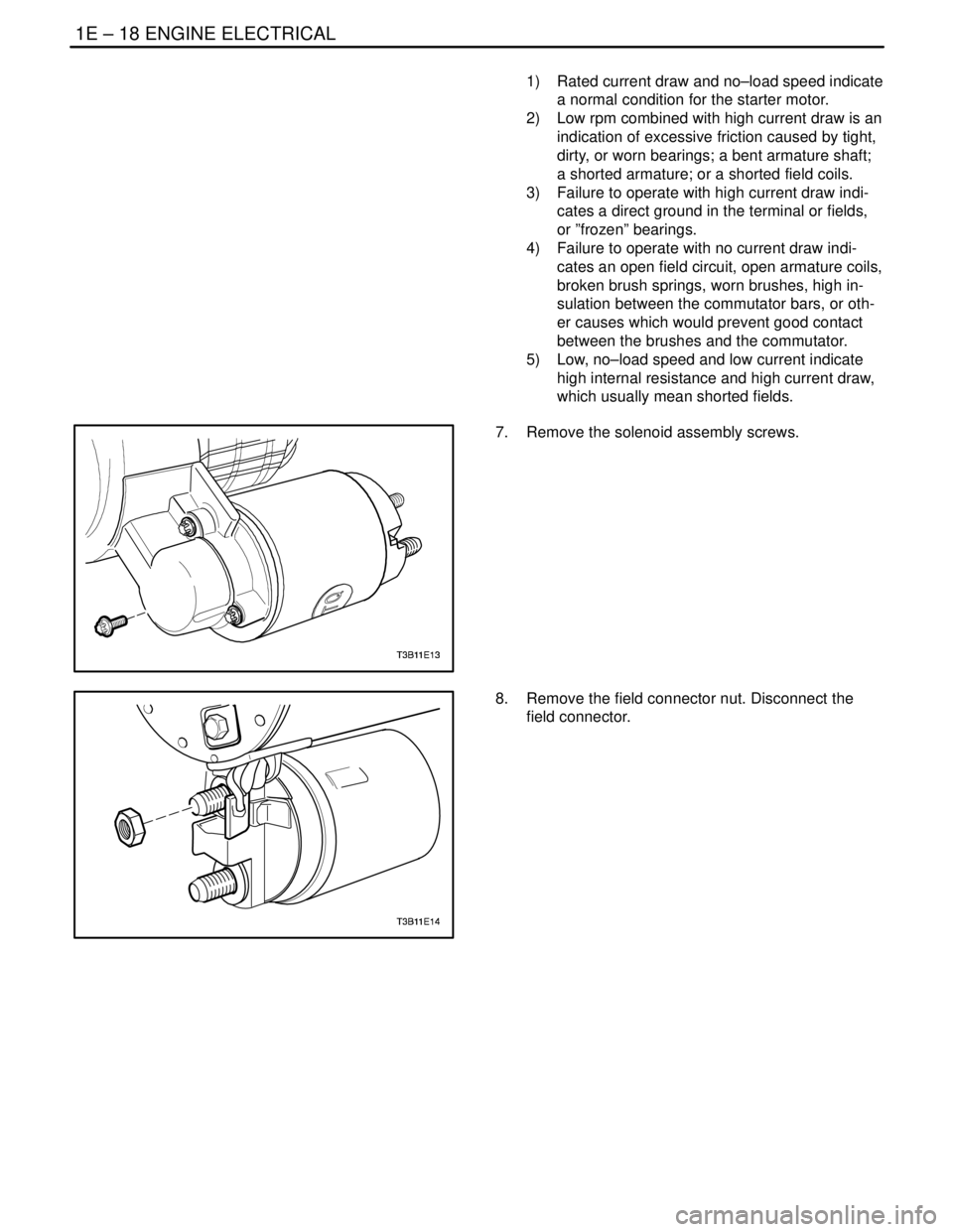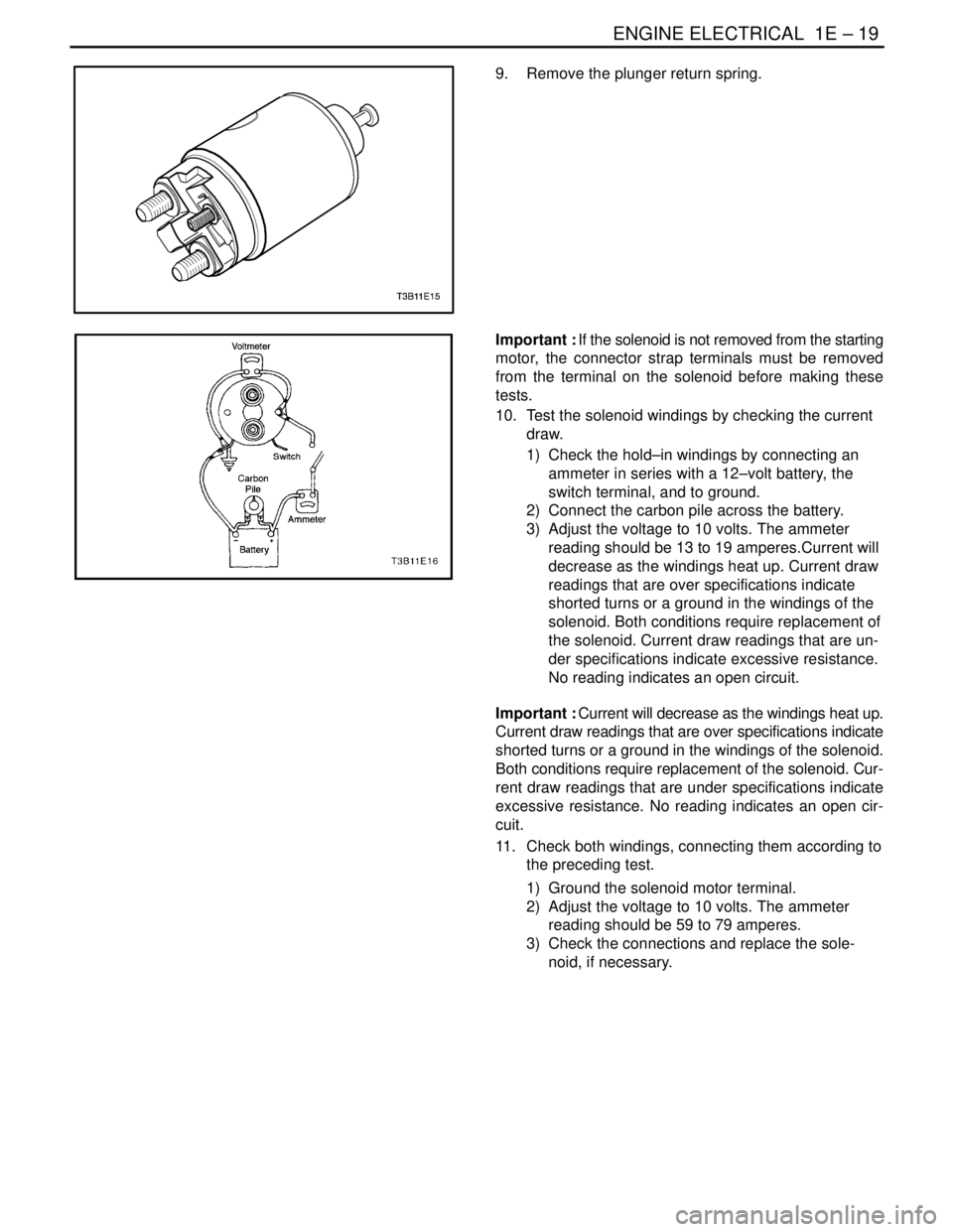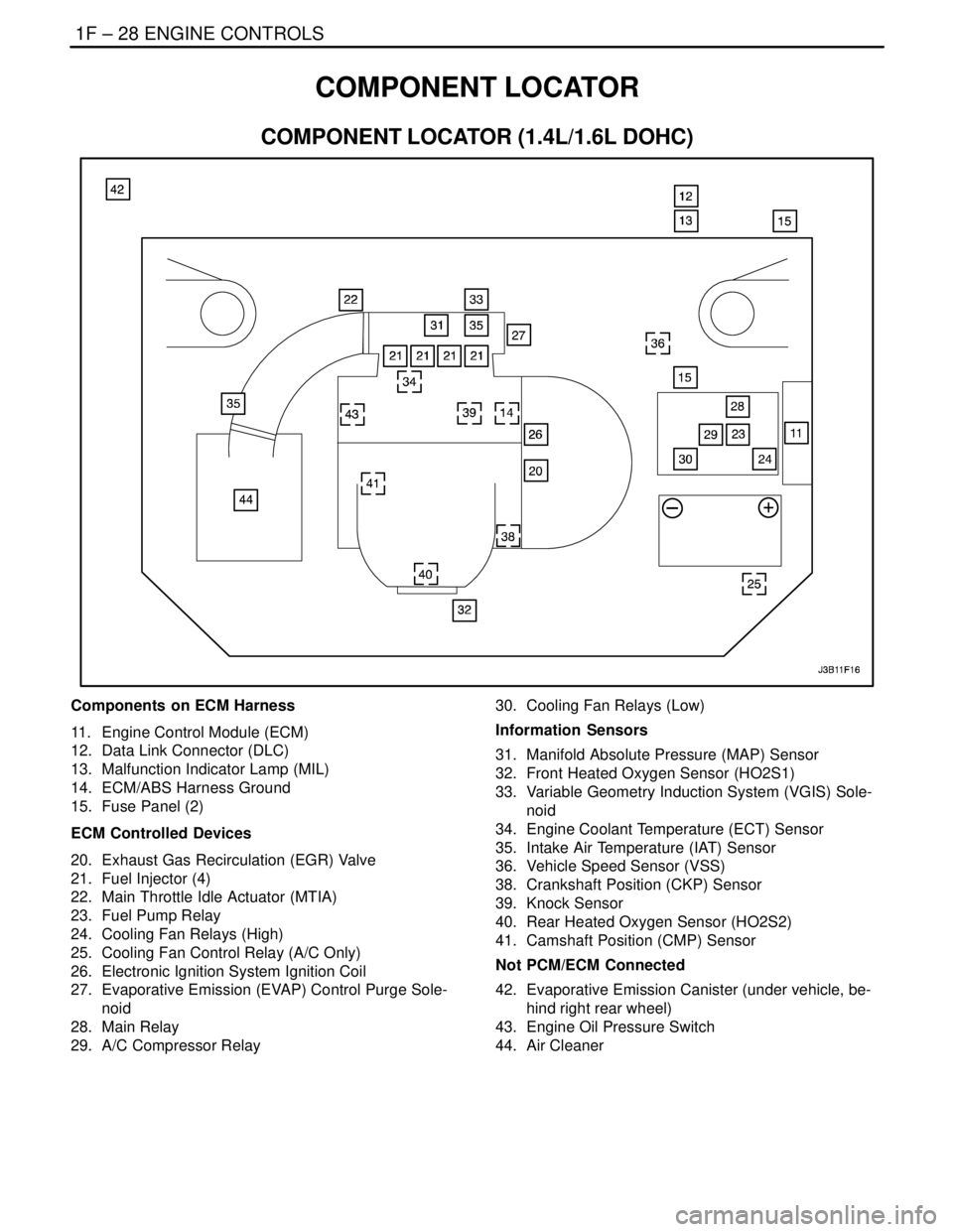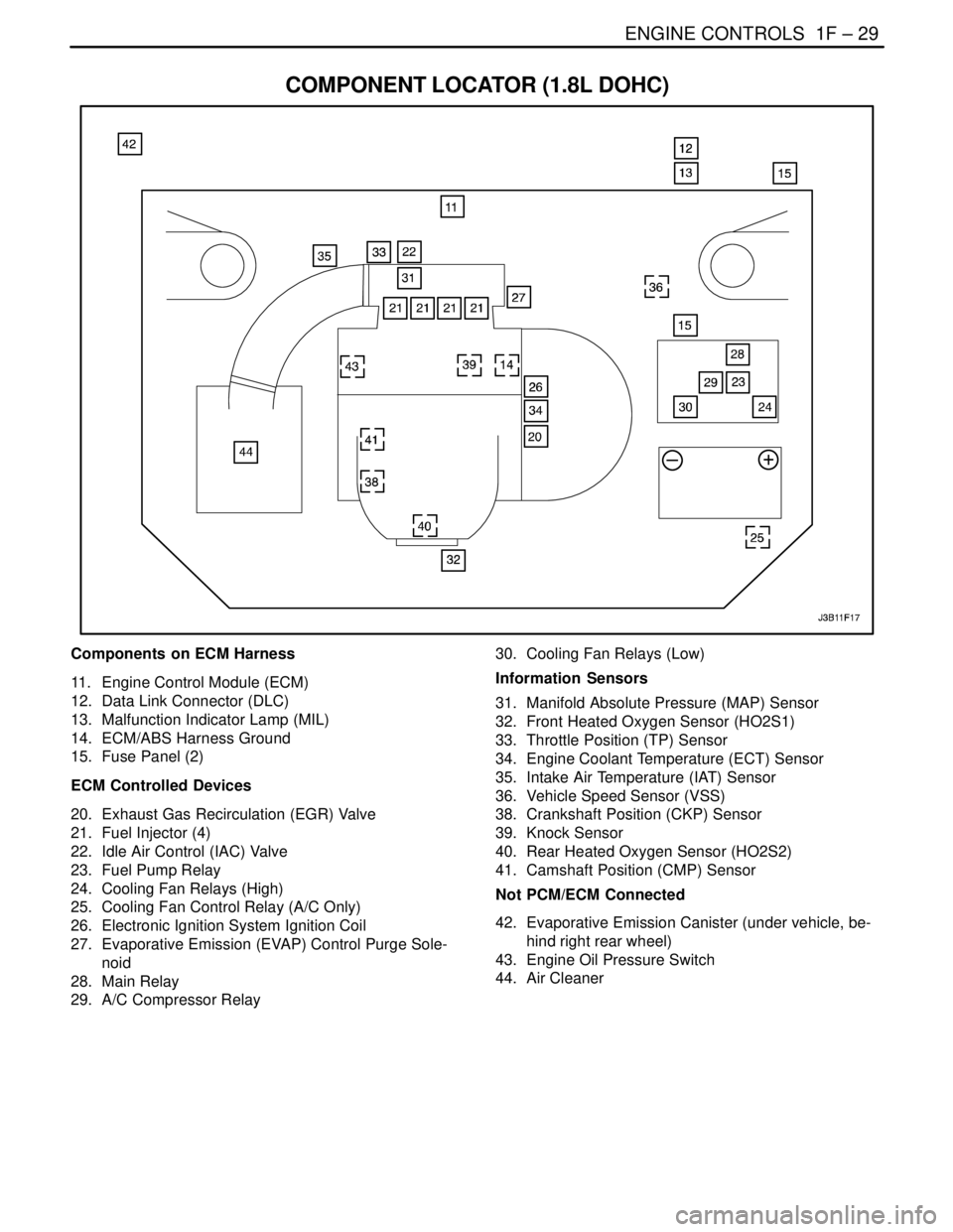2004 DAEWOO LACETTI Ground
[x] Cancel search: GroundPage 232 of 2643

1E – 18IENGINE ELECTRICAL
DAEWOO V–121 BL4
1) Rated current draw and no–load speed indicate
a normal condition for the starter motor.
2) Low rpm combined with high current draw is an
indication of excessive friction caused by tight,
dirty, or worn bearings; a bent armature shaft;
a shorted armature; or a shorted field coils.
3) Failure to operate with high current draw indi-
cates a direct ground in the terminal or fields,
or ”frozen” bearings.
4) Failure to operate with no current draw indi-
cates an open field circuit, open armature coils,
broken brush springs, worn brushes, high in-
sulation between the commutator bars, or oth-
er causes which would prevent good contact
between the brushes and the commutator.
5) Low, no–load speed and low current indicate
high internal resistance and high current draw,
which usually mean shorted fields.
7. Remove the solenoid assembly screws.
8. Remove the field connector nut. Disconnect the
field connector.
Page 233 of 2643

ENGINE ELECTRICAL 1E – 19
DAEWOO V–121 BL4
9. Remove the plunger return spring.
Important : If the solenoid is not removed from the starting
motor, the connector strap terminals must be removed
from the terminal on the solenoid before making these
tests.
10. Test the solenoid windings by checking the current
draw.
1) Check the hold–in windings by connecting an
ammeter in series with a 12–volt battery, the
switch terminal, and to ground.
2) Connect the carbon pile across the battery.
3) Adjust the voltage to 10 volts. The ammeter
reading should be 13 to 19 amperes.Current will
decrease as the windings heat up. Current draw
readings that are over specifications indicate
shorted turns or a ground in the windings of the
solenoid. Both conditions require replacement of
the solenoid. Current draw readings that are un-
der specifications indicate excessive resistance.
No reading indicates an open circuit.
Important : Current will decrease as the windings heat up.
Current draw readings that are over specifications indicate
shorted turns or a ground in the windings of the solenoid.
Both conditions require replacement of the solenoid. Cur-
rent draw readings that are under specifications indicate
excessive resistance. No reading indicates an open cir-
cuit.
11. Check both windings, connecting them according to
the preceding test.
1) Ground the solenoid motor terminal.
2) Adjust the voltage to 10 volts. The ammeter
reading should be 59 to 79 amperes.
3) Check the connections and replace the sole-
noid, if necessary.
Page 246 of 2643

1E – 32IENGINE ELECTRICAL
DAEWOO V–121 BL4
the same cable to the positive terminal on the other
battery. Never connect the other end to the nega-
tive terminal of the discharged battery.
CAUTION : To avoid injury do not attach the cable di-
rectly to the negative terminal of the discharged bat-
tery. Doing so could cause sparks and a possible bat-
tery explosion.
6. Clamp one end of the second cable to the negative
terminal of the booster battery. Make the final con-
nection to a solid engine ground (such as the en-
gine lift bracket) at least 450 millimeters (18 inches)
from the discharged battery.
7. Start the engine of the vehicle with the good bat-
tery. Run the engine at a moderate speed for sever-
al minutes. Then start the engine of the vehicle
which has the discharged battery.
8. Remove the jumper cables by reversing the above
sequence exactly. Remove the negative cable from
the vehicle with the discharged battery first. While
removing each clamp, take care that it does not
touch any other metal while the other end remains
attached.
GENERATOR
The Delco–Remy CS charging system has several mod-
els available, including the CS. The number denotes the
outer diameter in millimeters of the stator lamination.
CS generators are equipped with internal regulators. A
Delta stator, a rectifier bridge, and a rotor with slip rings
and brushes are electrically similar to earlier generators.
A conventional pulley and fan are used. There is no test
hole.
Unlike three–wire generators, the CS may be used with
only two connections: battery positive and an ”L’’ terminal
to the charge indicator lamp.
As with other charging systems, the charge indicator lamp
lights when the ignition switch is turned to RUN, and goes
out when the engine is running. If the charge indicator is
on with the engine running, a charging system defect is in-
dicated. This indicator light will glow at full brilliance for
several kinds of defects as well as when the system volt-
age is too high or too low.The regulator voltage setting varies with temperature and
limits the system voltage by controlling rotor field current.
At high speeds, the on–time may be 10 percent and the
off–time 90 percent. At low speeds, with high electrical
loads, on–time may be 90 percent and the off–time 10 per-
cent.
CHARGING SYSTEM
CS generators use a new type of regulator that incorpo-
rates a diode trio. A Delta stator, a rectifier bridge, and a
rotor with slip rings and brushes are electrically similar to
earlier generators. A conventional pulley and fan are used.
There is no test hole.
STARTER
Wound field starter motors have pole pieces, arranged
around the armature, which are energized by wound field
coils.
Enclosed shift lever cranking motors have the shift lever
mechanism and the solenoid plunger enclosed in the drive
housing, protecting them from exposure to dirt, icy condi-
tions, and splashes.
In the basic circuit, solenoid windings are energized when
the switch is closed. The resulting plunger and shift lever
movement causes the pinion to engage the engine fly-
wheel ring gear. The solenoid main contacts close. Crank-
ing then takes place.
When the engine starts, pinion overrun protects the arma-
ture from excessive speed until the switch is opened, at
which time the return spring causes the pinion to disen-
gage. To prevent excessive overrun, the switch should be
released immediately after the engine starts.
STARTING SYSTEM
The engine electrical system includes the battery, the igni-
tion, the starter, the generator, and all the related wiring.
Diagnostic tables will aid in troubleshooting system faults.
When a fault is traced to a particular component, refer to
that component section of the service manual.
The starting system circuit consists of the battery, the
starter motor, the ignition switch, and all the related electri-
cal wiring. All of these components are connected electri-
cally.
Page 274 of 2643

1F – 28IENGINE CONTROLS
DAEWOO V–121 BL4
COMPONENT LOCATOR
COMPONENT LOCATOR (1.4L/1.6L DOHC)
Components on ECM Harness
11. Engine Control Module (ECM)
12. Data Link Connector (DLC)
13. Malfunction Indicator Lamp (MIL)
14. ECM/ABS Harness Ground
15. Fuse Panel (2)
ECM Controlled Devices
20. Exhaust Gas Recirculation (EGR) Valve
21. Fuel Injector (4)
22. Main Throttle Idle Actuator (MTIA)
23. Fuel Pump Relay
24. Cooling Fan Relays (High)
25. Cooling Fan Control Relay (A/C Only)
26. Electronic Ignition System Ignition Coil
27. Evaporative Emission (EVAP) Control Purge Sole-
noid
28. Main Relay
29. A/C Compressor Relay30. Cooling Fan Relays (Low)
Information Sensors
31. Manifold Absolute Pressure (MAP) Sensor
32. Front Heated Oxygen Sensor (HO2S1)
33. Variable Geometry Induction System (VGIS) Sole-
noid
34. Engine Coolant Temperature (ECT) Sensor
35. Intake Air Temperature (IAT) Sensor
36. Vehicle Speed Sensor (VSS)
38. Crankshaft Position (CKP) Sensor
39. Knock Sensor
40. Rear Heated Oxygen Sensor (HO2S2)
41. Camshaft Position (CMP) Sensor
Not PCM/ECM Connected
42. Evaporative Emission Canister (under vehicle, be-
hind right rear wheel)
43. Engine Oil Pressure Switch
44. Air Cleaner
Page 275 of 2643

ENGINE CONTROLS 1F – 29
DAEWOO V–121 BL4
COMPONENT LOCATOR (1.8L DOHC)
Components on ECM Harness
11. Engine Control Module (ECM)
12. Data Link Connector (DLC)
13. Malfunction Indicator Lamp (MIL)
14. ECM/ABS Harness Ground
15. Fuse Panel (2)
ECM Controlled Devices
20. Exhaust Gas Recirculation (EGR) Valve
21. Fuel Injector (4)
22. Idle Air Control (IAC) Valve
23. Fuel Pump Relay
24. Cooling Fan Relays (High)
25. Cooling Fan Control Relay (A/C Only)
26. Electronic Ignition System Ignition Coil
27. Evaporative Emission (EVAP) Control Purge Sole-
noid
28. Main Relay
29. A/C Compressor Relay30. Cooling Fan Relays (Low)
Information Sensors
31. Manifold Absolute Pressure (MAP) Sensor
32. Front Heated Oxygen Sensor (HO2S1)
33. Throttle Position (TP) Sensor
34. Engine Coolant Temperature (ECT) Sensor
35. Intake Air Temperature (IAT) Sensor
36. Vehicle Speed Sensor (VSS)
38. Crankshaft Position (CKP) Sensor
39. Knock Sensor
40. Rear Heated Oxygen Sensor (HO2S2)
41. Camshaft Position (CMP) Sensor
Not PCM/ECM Connected
42. Evaporative Emission Canister (under vehicle, be-
hind right rear wheel)
43. Engine Oil Pressure Switch
44. Air Cleaner
Page 276 of 2643

1F – 30IENGINE CONTROLS
DAEWOO V–121 BL4
DIAGNOSIS
SYSTEM DIAGNOSIS
DIAGNOSTIC AIDS
If an intermittent problem is evident, follow the guidelines
below.
Preliminary Checks
Before using this section you should have already per-
formed the ”On–Board Diagnostic System Check.”
Perform a thorough visual inspection. This inspection can
often lead to correcting a problem without further checks
and can save valuable time. Inspect for the following con-
ditions:
S Engine control module (ECM) grounds for being
clean, tight, and in their proper location.
S Vacuum hoses for splits, kinks, collapsing and prop-
er connections as shown on the Vehicle Emission
Control Information label. Inspect thoroughly for
any type of leak or restriction.
S Air leaks at the throttle body mounting area and the
intake manifold sealing surfaces.
S Ignition wires for cracks, hardness, proper routing,
and carbon tracking.
S Wiring for proper connections.
S Wiring for pinches or cuts.
Diagnostic Trouble Code Tables
Do not use the Diagnostic Trouble Code (DTC) tables to
try to correct an intermittent fault. The fault must be pres-
ent to locate the problem.
Incorrect use of the DTC tables may result in the unneces-
sary replacement of parts.
Faulty Electrical Connections or Wiring
Most intermittent problems are caused by faulty electrical
connections or wiring. Perform a careful inspection of sus-
pect circuits for the following:
S Poor mating of the connector halves.
S Terminals not fully seated in the connector body.
S Improperly formed or damaged terminals. All con-
nector terminals in a problem circuit should be care-
fully inspected, reformed, or replaced to insure con-
tact tension.S Poor terminal–to–wire connection. This requires
removing the terminal from the connector body.
Road Test
If a visual inspection does not find the cause of the prob-
lem, the vehicle can be driven with a voltmeter or a scan
tool connected to a suspected circuit. An abnormal voltage
or scan tool reading will indicate that the problem is in that
circuit.
If there are no wiring or connector problems found and a
DTC was stored for a circuit having a sensor, except for
DTC P0171 and DTC P0172, replace the sensor.
Fuel System
Some intermittent driveability problems can be attributed
to poor fuel quality. If a vehicle is occasionally running
rough, stalling, or otherwise performing badly, ask the cus-
tomer about the following fuel buying habits:
S Do they always buy from the same source? If so,
fuel quality problems can usually be discounted.
S Do they buy their fuel from whichever fuel station
that is advertising the lowest price? If so, check the
fuel tank for signs of debris, water, or other contam-
ination.
IDLE LEARN PROCEDURE
Whenever the battery cables, the engine control module
(ECM), or the ECM fuse is disconnected or replaced, the
following idle learn procedure must be performed:
1. Turn the ignition ON for 5 seconds.
2. Turn the ignition OFF for 5 seconds.
3. Turn the ignition ON for 5 seconds.
4. Start the engine in park/neutral.
5. Allow the engine to run until the engine coolant is
above 185° F (85°C ).
6. Turn the A/C ON for 10 seconds, if equipped.
7. Turn the A/C OFF for 10 seconds, if equipped.
8. If the vehicle is equipped with an automatic trans-
axle, apply the parking brake. While pressing the
brake pedal, place the transaxle in D (drive).
9. Turn the A/C ON for 10 seconds, if equipped.
10. Turn the A/C OFF for 10 seconds, if equipped.
11. Turn the ignition OFF. The idle learn procedure is
complete.
Page 278 of 2643

1F – 32IENGINE CONTROLS
DAEWOO V–121 BL4
ON–BOARD DIAGNOSTIC (EOBD) SYSTEM CHECK
(1.4L/1.6L DOHC)
Circuit Description
The On–Board Diagnostic (EOBD) system check is the
starting point for any driveability complaint diagnosis. Be-
fore using this procedure, perform a careful visual/physi-
cal check of the engine control module (ECM) and the en-
gine grounds for cleanliness and tightness.
The EOBD system check is an organized approach to
identifying a problem created by an electronic engine con-
trol system malfunction.
Diagnostic Aids
An intermittent may be caused by a poor connection,
rubbed–through wire insulation or a wire broken inside the
insulation. Check for poor connections or a damaged har-
ness. Inspect the ECM harness and connections for im-
proper mating, broken locks, improperly formed or dam-
aged terminals, poor terminal–to–wire connection, and
damaged harness.Test Description
Numbers below refer to the step number on the Diagnostic
Chart:
1. The Malfunction Indicator Lamp (MIL) should be
ON steady with the ignition ON and the engine
OFF. If not, go to ”Diagnostic Aids”.
2. Checks the Class 2 data circuit and ensures that
the ECM is able to transmit serial data.
3. This test ensures that the ECM is capable of con-
trolling the MIL and the MIL driver circuit is not
shorted to ground.
4. If the engine will not start, refer to ”Engine Cranks
But Will Not Run” in this section.
7. A scan tool parameter which is not within the typical
range may help to isolate the area which is causing
the problem.
10. This vehicle is equipped with a ECM which utilizes
an Electrically Erasable Programmable Read Only
Memory (EEPROM). The replacement ECM must
be programmed. Refer to the latest Techline proce-
dure for ECM reprogramming.
Page 279 of 2643

ENGINE CONTROLS 1F – 33
DAEWOO V–121 BL4
On–Board Diagnostic (EOBD) System Check (1.4L/1.6L DOHC)
StepActionValue(s)YesNo
11. Turn the ignition switch to ON.
2. Observe the Malfunction Indicator Lamp (MIL).
Is the MIL illuminate?–Go to Step 2Go to
”No Malfunction
Indicator Lamp”
21. Turn the ignition switch to LOCK.
2. Install the scan tool to the Data link Connector
(DLC).
3. Turn the ignition switch to ON.
4. Attempt to display the Engine Control Module
(ECM) engine data with the scan tool.
Does the scan tool display the ECM engine data?–Go to Step 3Go to Step 8
31. Using the scan tool output test function, select
the MIL lamp control and command the MIL off.
2. Observe the MIL.
Does the MIL turn OFF?–Go to Step 4Go to
”Malfunction In-
dicator Lamp
on Steady”
4Attempt to start the engine.
Does the engine start and continue to run?–Go to Step 5Go to
”Engine Cranks
But Will Not
Run”
5Select DISPLAY DTC with the scan tool.
Are any Diagnostic Trouble Codes (DTCs) stored?–Go to Step 6Go to Step 7
6Check the display for DTCs P0107, P0108, P0113,
P0118, P0122, P0123, P0712, P1392.
Are two or more of the following DTCs stored?–Go to
”Multiple ECM
Information
Sensor DTCs
Set”Go to applica-
ble DTC table
7Compare the ECM data values displayed on the
scan tool to the typical engine scan data values.
Are the displayed values normal or close to the typi-
cal values?–Go to
”ECM Output
Diagnosis”Go to indicated
component
system check
81. Turn the ignition switch to LOCK.
2. Disconnect the ECM connector.
3. Turn the ignition switch to ON.
4. Check the serial data circuit for an open, short
to ground, or short to voltage. Also check the
DLC ignition feed circuit for an open or short to
ground, and check the DLC ground circuits for
an open.
Is a problem found?–Go to Step 9Go to Step 10
9Repair the open, short to ground, or short to voltage
in the serial data circuit or the DLC ignition feed cir-
cuit.
Is the repair complete?–System OK–
101. Attempt to reprogram the ECM.
2. Attempt to display the ECM data with the scan
tool.
Does the scan tool display ECM engine data?–Go to Step 2Go to Step 11
11Replace the ECM.
Is the replacement complete?–System OK–